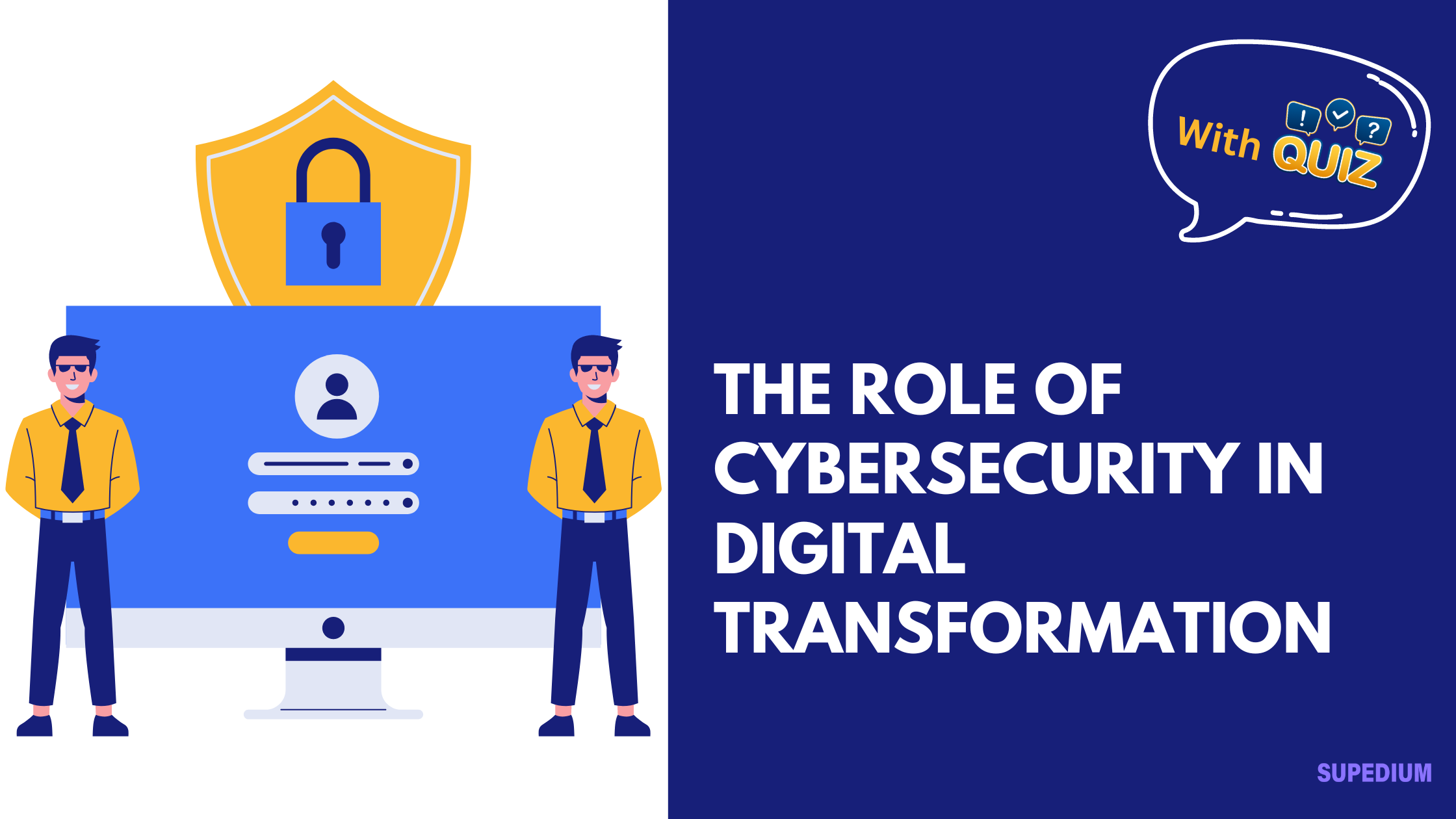Table of Contents
- 0.0.1 Introduction
- 0.0.2 The Relationship Between Digital Transformation and Cybersecurity
- 0.0.3 Key Areas of Cybersecurity Impact in Digital Transformation
- 0.0.4 Cybersecurity Strategies in Digital Transformation
- 0.0.5 Regulatory and Compliance Considerations
- 0.0.6 Case Studies and Examples
- 0.0.7 Future Trends and Developments
- 0.0.8 Conclusion
- 1 Quiz Time
![]()
Introduction
Digital Transformation refers to the profound integration of digital technology into every aspect of a business, fundamentally altering how operations are conducted and how value is delivered to customers. As organizations adopt new technologies to enhance efficiency, streamline operations, and innovate their services, they are simultaneously exposed to new risks and vulnerabilities.
Cybersecurity, on the other hand, involves practices and technologies designed to protect systems, networks, and data from cyber threats. The role of cybersecurity in digital transformation is critical, as it ensures that while organizations evolve digitally, their digital assets and data remain secure. This article explores the intersection of cybersecurity and digital transformation, highlighting how businesses can navigate this relationship to thrive in a digital-first world.
The Relationship Between Digital Transformation and Cybersecurity
Synergy Between Digital Transformation and Cybersecurity
Digital transformation and cybersecurity are intrinsically linked. On one hand, cybersecurity is essential for enabling secure digital innovation. As organizations implement new digital tools and platforms, robust security measures ensure that these technologies function without exposing the organization to undue risk. This synergy supports trust and confidence in digital operations, which is crucial for customer satisfaction and business continuity.
Challenges of Integrating Cybersecurity into Digital Transformation
Despite the benefits, integrating cybersecurity into digital transformation efforts presents several challenges. One major issue is balancing innovation with risk management. As organizations push the boundaries of technology to drive innovation, they must also ensure that these innovations do not introduce significant vulnerabilities. Additionally, the complexity of securing new technologies, such as cloud computing and Internet of Things (IoT) devices, adds another layer of difficulty. Addressing these challenges requires a proactive and integrated approach to cybersecurity.
Key Areas of Cybersecurity Impact in Digital Transformation
Cloud Computing
Cloud computing has revolutionized how organizations manage their IT resources, offering scalable and flexible solutions. However, the adoption of cloud services introduces new risks, including data breaches and misconfigured cloud settings. Best practices for securing cloud environments involve implementing strong access controls, encrypting sensitive data, and regularly monitoring cloud configurations for vulnerabilities.
Internet of Things (IoT)
The proliferation of IoT devices has created opportunities for increased operational efficiency but also brings significant security challenges. IoT devices are often targeted by cybercriminals due to their varied and sometimes inadequate security measures. Securing IoT ecosystems requires a multi-layered approach, including securing device firmware, employing network segmentation, and continuously monitoring for unusual activities.
Big Data and Analytics
Big data analytics provide valuable insights for decision-making but also pose risks related to data integrity and privacy. Protecting data within big data frameworks involves ensuring secure data storage, implementing robust encryption practices, and adhering to data governance policies. Additionally, organizations must safeguard analytics processes to prevent unauthorized access or manipulation of sensitive information.
Artificial Intelligence (AI) and Machine Learning (ML)
AI and ML technologies are transforming various business processes, from customer service to predictive analytics. However, these technologies also introduce new security considerations, such as the risk of adversarial attacks or biased decision-making. Safeguarding AI-driven systems involves implementing strong security protocols for data used in training models, regularly auditing AI systems for vulnerabilities, and ensuring that AI decisions are transparent and fair.
Cybersecurity Strategies in Digital Transformation
Risk Assessment and Management
Effective digital transformation requires a thorough understanding of potential cyber risks. Conducting regular risk assessments helps identify vulnerabilities associated with new digital initiatives. Developing risk mitigation strategies involves implementing appropriate security controls, such as firewalls and intrusion detection systems, and regularly updating them based on emerging threats.
Security by Design
Incorporating security measures during the design phase of digital solutions is crucial for minimizing risks. This approach, known as “security by design,” ensures that security considerations are embedded into the development process from the outset. Secure development practices include using secure coding techniques, conducting regular code reviews, and integrating security testing throughout the development lifecycle.
Incident Response and Recovery
Despite the best security measures, incidents may still occur. Preparing for and responding to cybersecurity incidents involves having a well-defined incident response plan. This plan should outline procedures for identifying, containing, and mitigating the impact of a breach. Additionally, establishing recovery plans ensures that the organization can quickly resume normal operations following an incident.
Employee Training and Awareness
Human factors play a significant role in cybersecurity. Educating employees on cybersecurity best practices and promoting a culture of security within the organization are essential for preventing breaches caused by human error. Regular training sessions, simulated phishing exercises, and clear communication about security policies help reinforce the importance of cybersecurity.
Regulatory and Compliance Considerations
Overview of Relevant Regulations and Standards
Organizations must navigate a complex landscape of regulations and standards related to cybersecurity. Examples include the General Data Protection Regulation (GDPR), the California Consumer Privacy Act (CCPA), and the Health Insurance Portability and Accountability Act (HIPAA). Compliance with these regulations ensures that organizations protect sensitive data and avoid legal repercussions.
Ensuring Compliance During Digital Transformation
Meeting regulatory requirements during digital transformation involves implementing measures that align with relevant laws and standards. This includes conducting regular compliance audits, maintaining thorough documentation of security practices, and staying informed about changes in regulatory requirements.
Case Studies and Examples
Successful Integration of Cybersecurity in Digital Transformation
An example of successful cybersecurity integration is a leading financial institution that adopted a robust cybersecurity framework during its digital transformation. By incorporating advanced threat detection systems and conducting regular security assessments, the organization was able to protect sensitive financial data and maintain customer trust, ultimately achieving its digital transformation goals with minimal security incidents.
Cybersecurity Failures in Digital Transformation
In contrast, a prominent retail chain experienced a significant cybersecurity breach during its digital transformation efforts. The breach, caused by inadequate security measures for newly implemented e-commerce platforms, resulted in the exposure of customer data and financial losses. This incident highlights the importance of addressing cybersecurity comprehensively when pursuing digital transformation.
Future Trends and Developments
Emerging Cybersecurity Technologies
The cybersecurity landscape is constantly evolving with new technologies designed to enhance threat detection and prevention. Innovations such as blockchain technology, which provides a decentralized and immutable ledger, and zero-trust architecture, which enforces strict access controls, are expected to play a crucial role in future cybersecurity strategies.
Evolving Threat Landscape
As digital transformation progresses, so too do cyber threats. Organizations must anticipate future challenges, such as sophisticated ransomware attacks or advanced persistent threats, and adapt their security measures accordingly. Staying ahead of the threat landscape requires continuous monitoring, research, and investment in cutting-edge security technologies.
Conclusion
In conclusion, cybersecurity plays an essential role in the success of digital transformation initiatives. By integrating robust security measures into digital strategies, organizations can safeguard their assets, build trust with customers, and drive innovation. As digital technologies continue to evolve, so too must cybersecurity practices, ensuring that businesses remain resilient in the face of emerging threats. Organizations are encouraged to prioritize cybersecurity in their digital initiatives, continuously evaluate and adapt their security measures, and stay informed about the latest developments in the cybersecurity field.






Be the first to comment